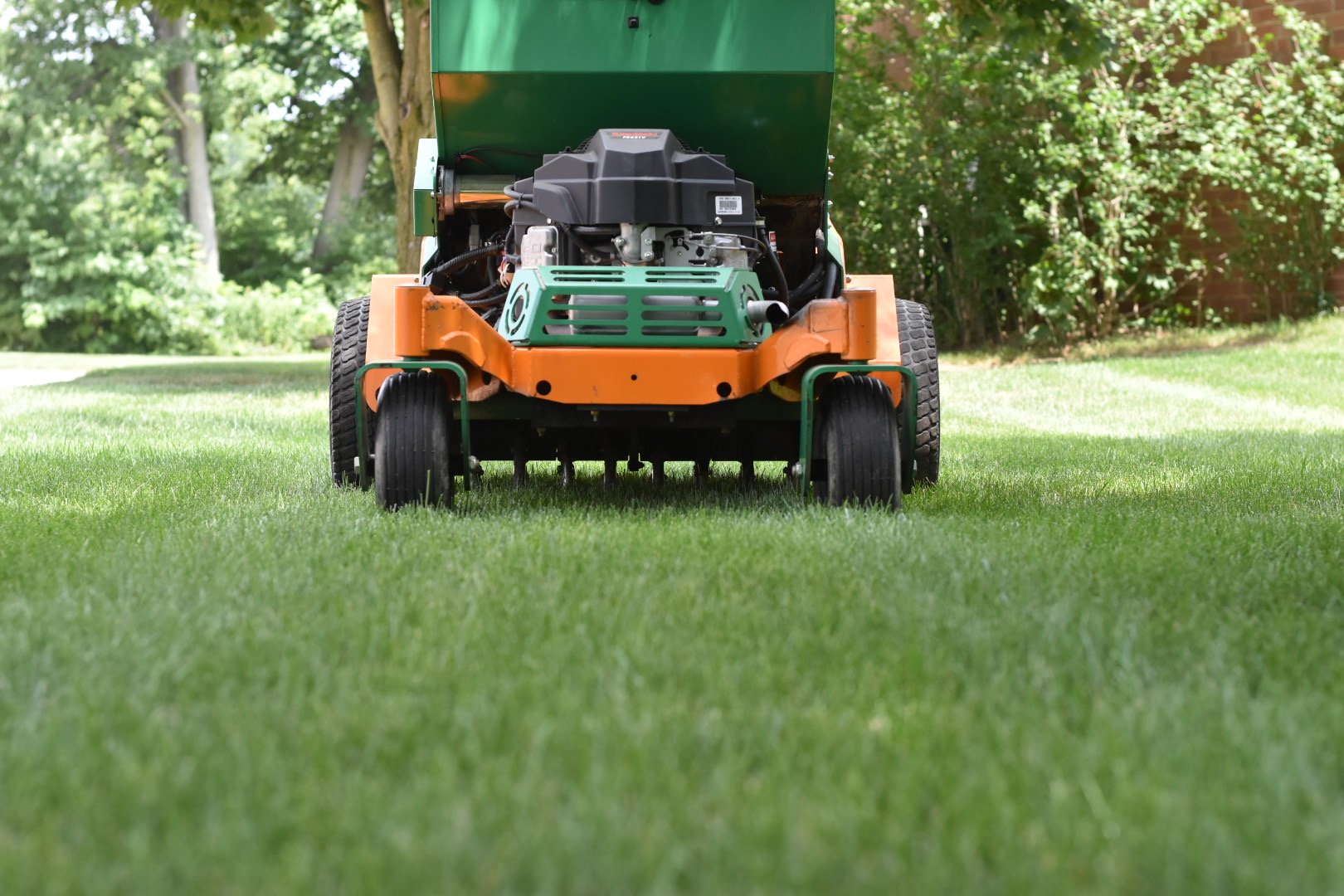
Aeration and Overseeding in Ohio: What Your Lawn Really Needs and When It Needs It
Core lawn aeration and lawn overseeding are more than just “nice-to-haves” for your Northeast OH lawn. In many cases, they are “must-haves” if you wish to achieve a perfectly green and lush lawn.
If you really think about it, conditions in Northeast OH aren’t always the most favorable for keeping your grass green. Hot summer temperatures can bring drought stress to your lawn. Clay and sandy soils can become compacted over time. Hot and humid conditions can invite weeds and disease to your lawn. And even large trees, common in this area, can inhibit grass from growing in the shady areas beneath them.
All of this can lead to brown grass, thinning areas, and even bare spots within your lawn, leaving you feeling hopeless about the state of your yard.
However, there’s no need to despair. Through lawn aeration and lawn overseeding, you can combat these issues and bring the green back to your grass.
Here’s a look at what lawn aeration and overseeding are and why they may be one of the best decisions you make for the health of your yard.
Table of Contents
- What Aeration and Overseeding Do For Your Lawn (and Why They’re Better Together)
- How to Tell If Your Lawn Really Needs Aeration or Overseeding
- When to Aerate and Overseed in Northeast Ohio
- How Soil and Grass Type Affect Results in Ohio Yards
- Top Mistakes That Sabotage Aeration and Overseeding
- Should You DIY or Hire a Pro? Here’s What Matters Most
- Your Seasonal Lawn Recovery Plan: A Northeast Ohio Yearly Strategy
- FAQs About Aeration & Overseeding in Ohio

What Lawn Aeration and Overseeding Do For Your Lawn (and Why They’re Better Together)
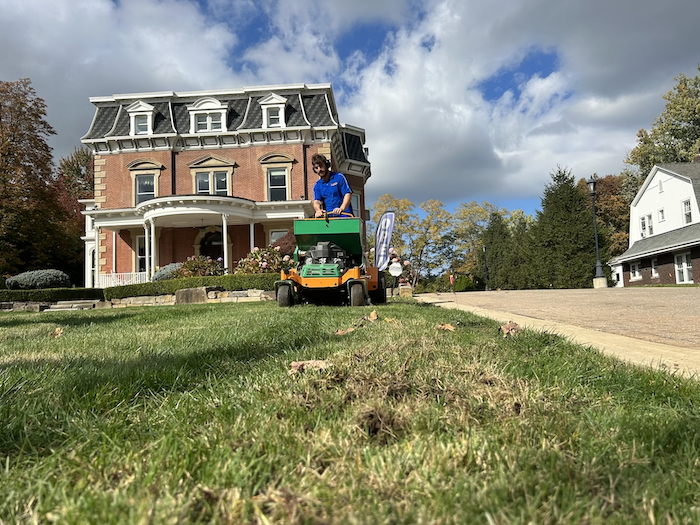
What Are Core Aeration And Overseeding?
So, what are core lawn aeration and overseeding? Before jumping into the benefits, let’s look at what these services entail.
The process of lawn aeration creates small holes about 3 to 4 inches deep in the soil. The thousands of plugs—also known as cores—pulled from the lawn reduce the overall compaction and thatch buildup in a yard.
What’s more, it also allows more air, nutrients, and water to penetrate into the soil.
Lawn overseeding involves dispersing grass over a lawn that already exists to thicken up grass, eliminate bare spots, and bring in new types of grass.
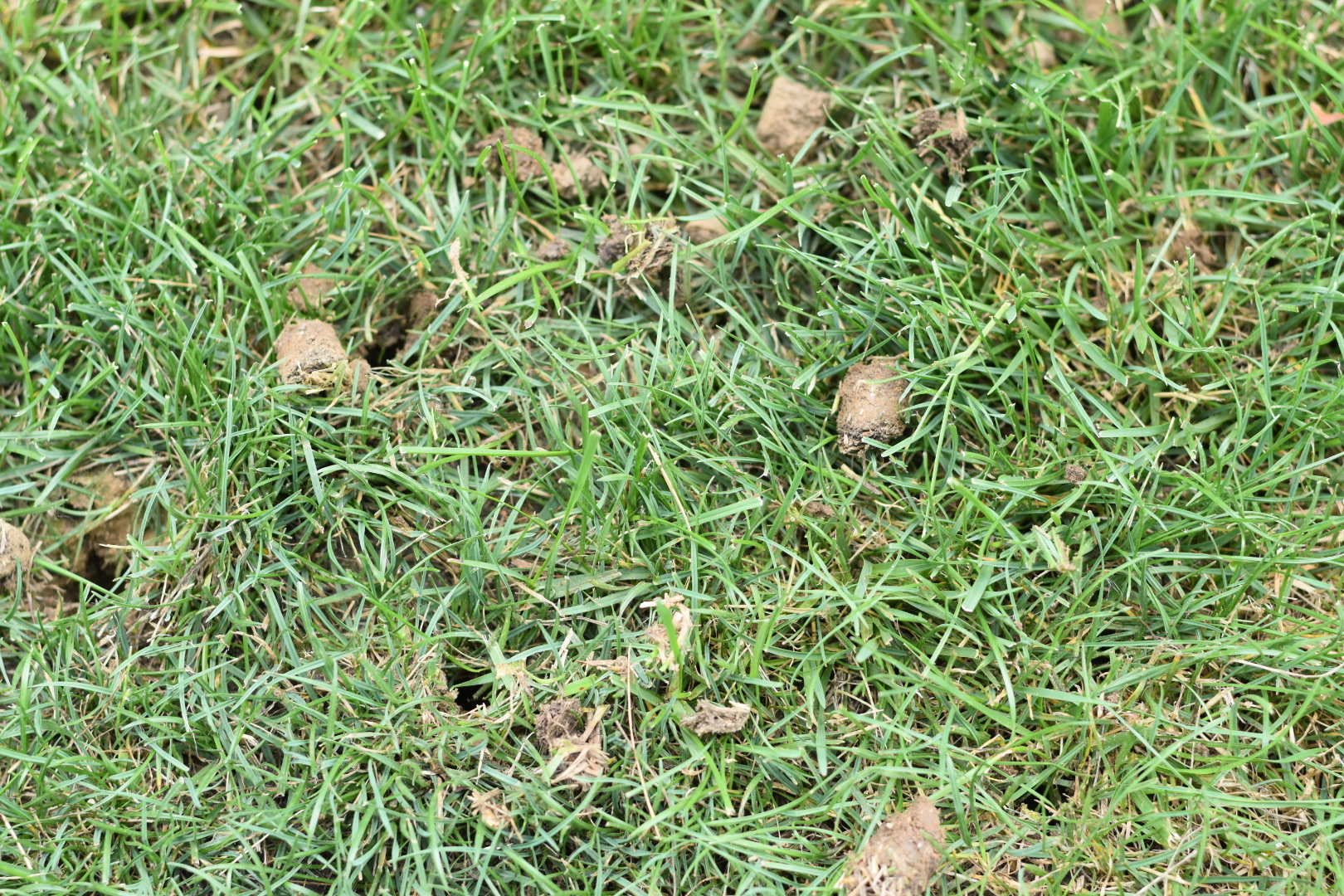
Do I Really Need Both Services?
While it’s possible to aerate and overseed separately, the best method is to perform them at the same time.
For instance, if you were only to aerate, that would break up compaction, but you’re not introducing any new varieties of grass into your yard. And, if you were only to overseed, you’re not giving those seeds the best chance to flourish because it would require more effort for them to take root in the soil.
At Turf Pride, we use a ride-on machine to pull the cores from the yard while dropping seed directly into the holes made by aeration simultaneously.
Not only is this the most efficient technique because we’re essentially performing two services at the same time, but it also reduces waste because the grass seed is dropped directly into the holes rather than being scattered wastefully across the lawn. This helps eliminate the grass seeds’ exposure to the elements—and even birds looking for a snack.
It also boosts the overall germination rate because the seeds can immediately start taking root in the soil and properly grow once they’re properly watered in.
As you can probably already tell, the benefits of lawn aeration and overseeding are as bountiful as the grass that will grow once you implement these services.
/tech%20showing%20customer%20flyer%20about%20services.jpg?width=1600&height=902&name=tech%20showing%20customer%20flyer%20about%20services.jpg)
How to Tell If Your Lawn Really Needs Aeration or Overseeding
There are several reasons your lawn may need to be core aerated and overseeded.
If you answer “yes” to any of the following questions, your yard can definitely benefit from these services.
1. Your Soil is Compacted
Do you notice puddles or areas of standing water in your yard? Does your yard experience constant drainage issues? Is your yard regularly traveled by people, pets, or wildlife? If you were to put something like a stake or screwdriver in the ground, would it be difficult to even insert it into the soil?
All of these could be signs that your soil is compacted.
/crew%20inspecting%20lawn%20up%20close%20for%20weeds.jpg?width=1600&height=902&name=crew%20inspecting%20lawn%20up%20close%20for%20weeds.jpg)
2. Your Thatch Layer is Thick
Thatch is a collection of dead and living organic material that collects above the soil. If it’s more than a half-inch thick, it may be difficult for soil to get the nutrients, air, and water it requires.
If the thatch layer turns out to be 1 inch thick or more, a dethatcher may be required. Essentially a big rake that grabs grass and tears it out, this tool gets rid of the thatch layer, but it also takes a lot of good healthy grass with it. That’s why you want to address the thatch layer before it gets to the point where this technique is necessary.
Keep in mind that a small layer of thatch is necessary to retain water, provide shade for the soil, and allow roots of the grass to absorb the water and nutrients from the soil.
“Try this at home” DIY test ideas
To determine if your soil is compacted or if you have a thick thatch layer, a simple soil probe test will tell you all you need to know about your soil.
Step 1: Insert A Probe Into The Soil. If you insert a soil probe into the ground, and it’s difficult to get it into the ground, your soil is likely compacted.
Step 2: Inspect The Core. You can tell a lot about your soil by the core, such as soil type and how much water is getting into the soil. In Northeast OH, you probably have sandy or clay soil. If sandy soil isn’t getting enough water, it will simply crumble on the spot, and it won’t even form a shapely core. If clay soil is compacted, it will be difficult to remove the core from the probe itself.
Step 3: Evaluate The Thatch Layer. From that soil sample, you can also visually see how thick the thatch layer is. Spongy, brown in color, and typically less dense than the soil, the thatch layer can be easily removed from the soil layer. It may even resemble a woven mat.
3. Your Lawn is Thin And/Or Discolored
Does your lawn look a little lifeless? Is it not as green as it could be? Are you thinking it could be more lush?
It could be that your lawn isn’t getting the proper nutrients. Aeration will alleviate this. It could also be that the grass you have isn’t best suited for Northeast OH. This is where overseeding comes in to introduce new varieties into your yard.
/inspecting%20lawn%20close%20up.jpg?width=1600&height=1067&name=inspecting%20lawn%20close%20up.jpg)
4. Your Lawn Exhibits Bare Spots
Do you have a lot of trees in your yard creating shade? Or do you have a pet that consistently urinates in the same spot?
Large trees, for example, require a lot of water, and they draw water out of the grass through their roots, causing the lawn underneath to thin quickly. Additionally, if trees are not regularly pruned, they create more shade, which means the grass underneath has a hard time growing due to lack of sunlight.
Bare spots due to pet urination can also be treated with aeration and overseeding, in addition to introducing a grass that can withstand damage, such as tall fescue.
Note, however, that if you’ve tried aerating and overseeding several years in a row underneath large trees to no avail, it may be time to create landscape beds and cover the area with mulch or fill in the area with xeriscaping.
/TurfPrideSpring2022(WebOptimized)-276.jpg?width=1600&height=902&name=TurfPrideSpring2022(WebOptimized)-276.jpg)
When to Aerate and Overseed in Northeast Ohio
Fall is overwhelmingly the best time to aerate and overseed your lawn. Our technicians typically lawn aerate and overseed in the sweet spot between Aug. 15 and Oct. 15, following regulations from the Ohio Department of Agriculture.
Let’s take a look at why.
Winter = Dormant Grass
In Northeast OH, you may not even be able to see your grass under the snow cover in wintertime. And, even if you can, the grass is dormant in the winter, meaning aerating and planting new seeds will not result in new growth.
Spring = High Weed Pressure
As your lawn comes out of dormancy, so do the weeds. By pulling out thousands of plugs from your lawn when aerating, you’re providing a lot of space for weeds to infiltrate and take available space away from the grass.
Summer = High Heat, Low Moisture, and High Weed Activity
In Northeast Ohio, summer’s heat and dry spells can take a toll on your lawn, meaning that it’s not the time to stress it out further by pulling out thousands of cores.
The lower moisture levels also mean that the grass seedlings will have to fight harder to push up out of the soil.
Fall = The Perfect Time
Fall brings cooler weather and more consistent rainfall—ideal conditions for grass to recover and thrive. During this time, your lawn can heal from summer stress and develop a deeper, stronger root system before facing the Northeast OH winter.
 Additionally, weed activity tends to slow down in the fall, giving new grass seedlings from overseeding a better chance to grow without as much competition for nutrients and space.
Additionally, weed activity tends to slow down in the fall, giving new grass seedlings from overseeding a better chance to grow without as much competition for nutrients and space.
Aerating and overseeding in the fall also enhance the impact of fertilization, setting the stage for a healthier, more vibrant lawn come spring.
Note that if hot and dry weather lingers later into the fall season, you may need to put in a bit of extra effort to keep the soil moist and help the new seeds establish.
How to Prepare Your Lawn for Aeration and Overseeding
Before our technicians come out to aerate and overseed, follow these steps for the best results.
- Be sure to flag invisible fences and sprinkler heads so we can avoid those areas with our machines.
- Cut the grass a little shorter than usual before the service. This helps ensure nice, even plugs are pulled from your lawn.
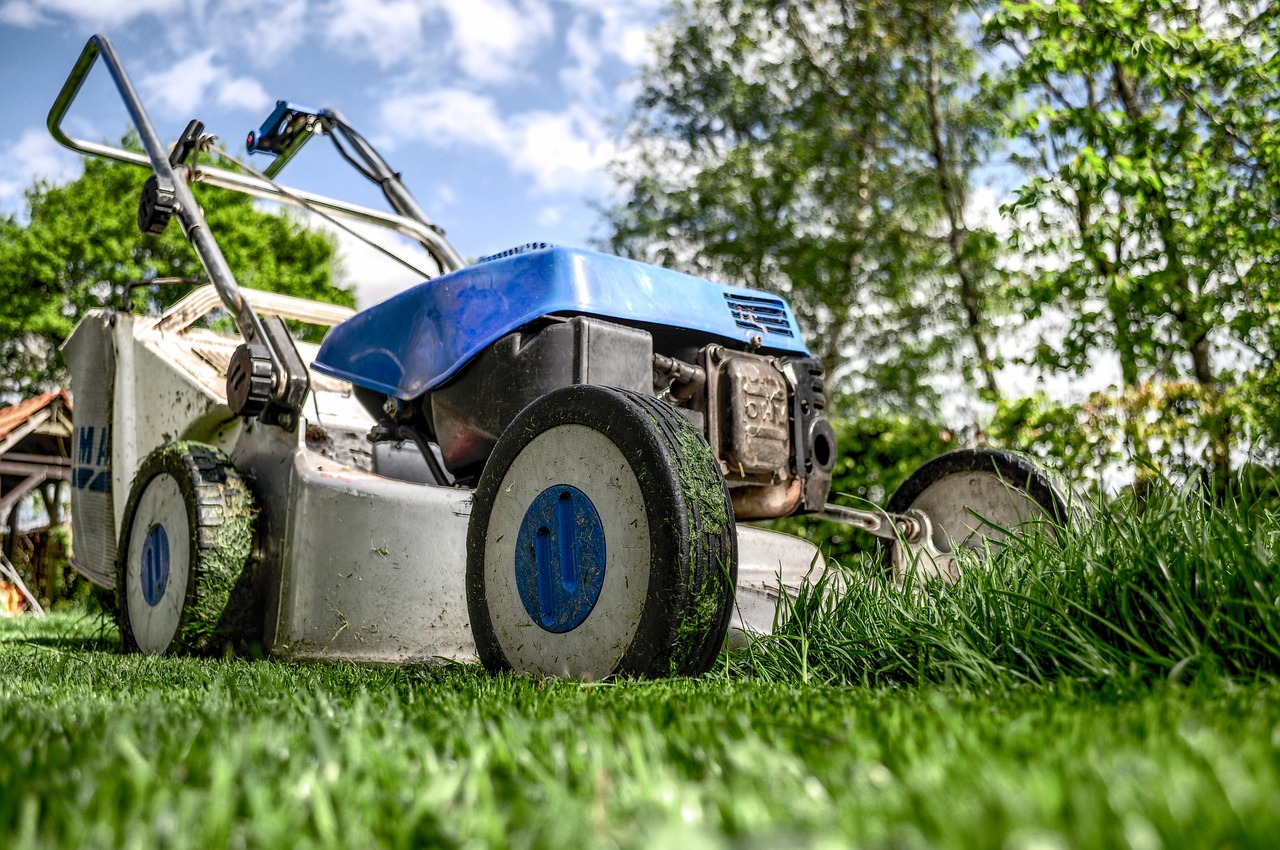
How Soil and Grass Type Affect Results in Ohio Yards
Depending on the soil and grass type you have in your yard, you may require aeration and overseeding services more often.
Common Soil Types in Northeast OH
First, let’s take a look at the most common soil conditions and some of the issues that may come along with those conditions.
Clay Soil.
Clay soil is naturally very thick, meaning that water can’t easily flow through it. This means that in lower areas in your yard, you may start to see water retention where the grass just never seems to grow because it can’t properly dry out.
Sandy Soil.
Sandy soil is more common in northern Mentor, closer to Lake Erie. While this type of soil allows water to flow through easily, it doesn’t easily retain water, meaning the lawn will dry out quickly and become compacted.
Best Grass Seed for Overseeding
Just as soil matters, so too does grass type. It’s especially important to match the grass type to the region to give it the best chance to survive and thrive.
We use a mixture of three different types of grass seed when we overseed. Here are the benefits of each:
- Perennial ryegrass has a fast germination period, so if you water in the seed regularly, you will start to see this type of grass start to grow within seven to 10 days.
- Kentucky bluegrass provides even growth with a blade that’s not too skinny or too wide and boasts a nice green color.
- Tall fescue stands up to pests well because it’s tough for insects to chew through. It also has a strong root system and a wide blade, allowing it to withstand other potential damage from the elements.
/lawn%20crew%20treating%20lawn%20with%20house%20in%20background.jpg?width=1600&height=902&name=lawn%20crew%20treating%20lawn%20with%20house%20in%20background.jpg)
Grass Types to Avoid
If you can, avoid seeding your yard with the following grass types.
- Fine fescue features a very narrow blade, causing it to struggle in the heat of summer, especially if it’s in direct sunlight. It also has a shallow root system, so it will dry out the fastest and go dormant first in the summer. It may work well in some shaded areas, but in sunny areas, it will brown out quickly and become prone to diseases like red thread disease and dollar spot.
- Creeping bentgrass, the grass most commonly found on golf courses, can stay green during summertime in wetter areas, but when exposed to direct sunlight, it will turn brown from dormancy. It also is very susceptible to disease and insects, such as grubs, and its shallow root system means it’s easy for animals to dig it up to access those insects.
Top Mistakes That Sabotage Aeration and Overseeding
Just like many important tasks, aeration and overseeding aren’t a one-time fix-all solution. Your yard will still require regular care and maintenance after we tackle these. You also may be wondering when to mow after aeration and overseeding and when it’s time to fertilize after aeration and overseeding.
Here’s a roundup of the top mistakes you as the homeowner might accidentally make that will undo aeration and overseeding efforts. Avoiding these pitfalls will help ensure strong germination and long-term lawn health.
1. Not Watering Your Lawn Consistently
Following these services, your lawn needs about a quarter-inch of water every day for two weeks, so watering your lawn after aeration and overseeding is crucial. This consistent moisture keeps the seeds damp and promotes healthy germination. If the lawn dries out, the seeds may fail to sprout, and you won’t get the desired results you were hoping for.
If your aeration service falls in mid-to-late August, this means you may need to water the lawn every day, especially if hot, dry weather persists.
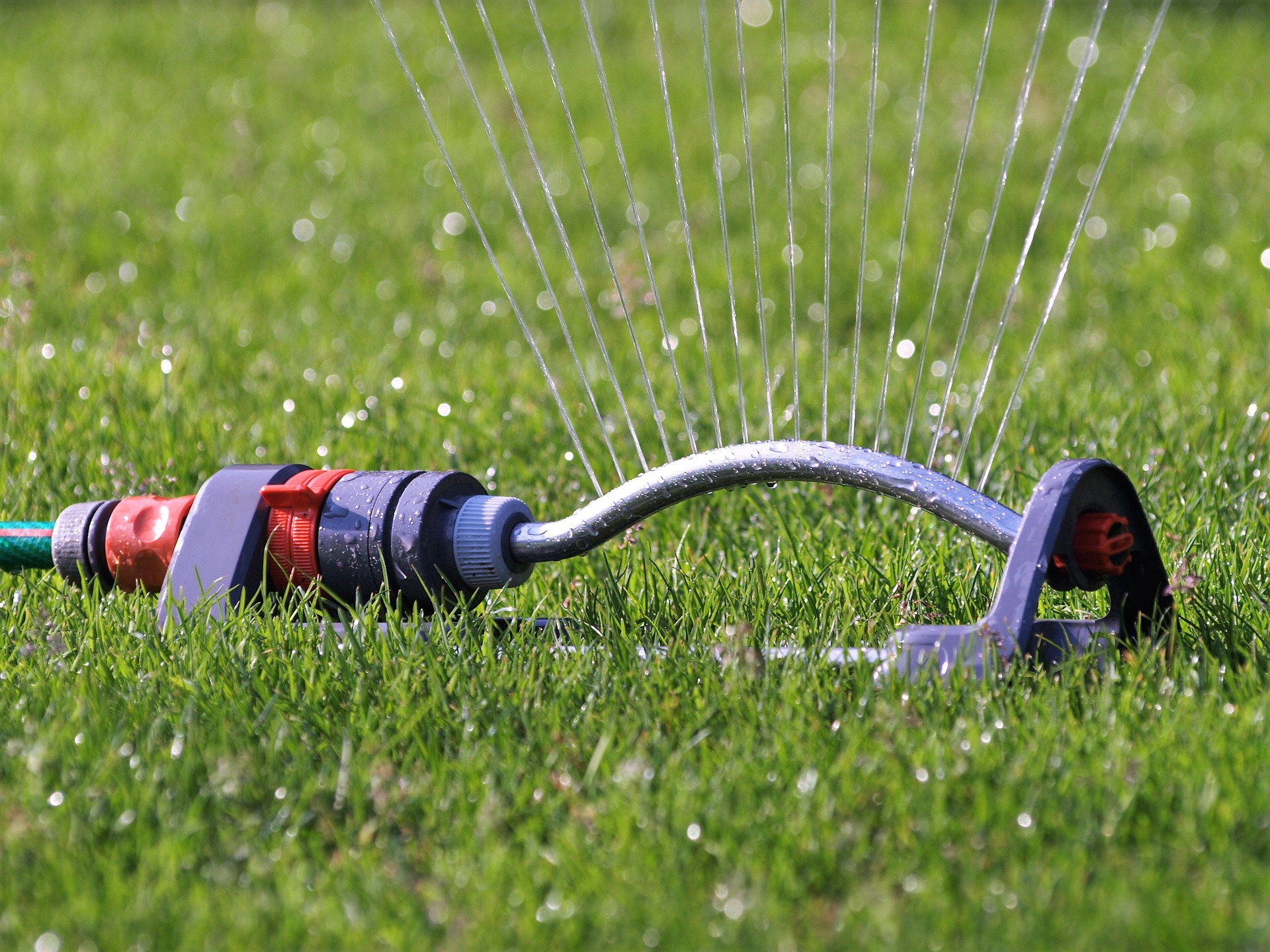
To know exactly how much water you’re applying to the lawn, place a small container or watering can within your sprinkler’s range (but not right next to the sprinkler head) and time how long it takes to collect a quarter-inch of water. Once that spot is sufficiently watered, move to the next area. You can then use that time as reference to know about how long it takes to sufficiently water your lawn and from there, create a watering schedule for your lawn.
2. Mowing Grass Too Short
While you may mow the grass just a little bit shorter right before aeration, be sure to not mow the grass too short directly after our services. Keeping the grass longer (about 3 inches) will help protect the young seedlings that have just been put down.
/lawn%20mowing%20height.jpg?width=1200&height=676&name=lawn%20mowing%20height.jpg)
3. Neglecting to Apply Fertilizer
For optimal results, consider applying a fertilizer treatment after aeration and overseeding. This is one of the best times for nutrients to reach the roots and support healthy, vigorous growth.
4. Not Limiting Foot Traffic
Try to keep people, pets, and equipment off your lawn while the new seedlings are establishing. With fall’s cooler weather, this should be fairly manageable and will help prevent soil compaction.
5. Picking up the Soil Plugs
The soil plugs left behind after aeration might look a bit messy, but don’t worry—they’ll naturally break down over time. As a bonus, they return valuable nutrients to the soil as they decompose.
6. Not Cleaning Up Heavy Leaves and Debris
If your aeration service falls toward the end of the optimal window, in late September or early to mid-October, heavy leaves and debris may impede sunlight from reaching that new seed. Clear this debris to ensure the seedlings get the air, water, sunlight, and nutrients they need to grow.

Should You DIY or Hire a Pro? Here’s What Matters Most
It is possible to “DIY” lawn aeration and overseeding, but by doing so, you could run into the following problems.
Improper Timing.
Our experts know exactly when the time is right to aerate and overseed based on dozens of years of personal experience and guidelines from top research entities.
Scarcity and Expense of Equipment and Supplies.
Sure, aerators and overseeders are available for rent at a variety of places, but because the optimal window in Northeast OH is only two months long, you may find that this equipment is scarce during this time. You will also need access to a car or truck capable of towing the aerator.
You will have to pay for all of these items, not to mention the grass seed, which can be costly as well.
Lack of Know-How.
If you decide to aerate and overseed yourself, not only do you need to know how to use the equipment, but you also need to know the perfect mix and amount of grass seed to put down. You also need to make sure your equipment is properly calibrated to pull the right size cores and put down the right amount of seed.
While spreading too little seed will obviously not get you the results you want, spreading too much will also hinder your results because the grass will simply choke itself out and die. It needs ample space to grow.
/TurfPrideSpring2022(WebOptimized)-8.jpg?width=1600&height=902&name=TurfPrideSpring2022(WebOptimized)-8.jpg)
Shortage of Time and Energy.
Even if you have the timing down, the proper equipment, and just the right mix of grass seed, you may not want to deal with the headache of aerating and overseeding.
After all, late summer and early fall offer the last few chances for you to enjoy the outdoor weather with your family and friends, so why waste your time on something that could be taken off your shoulders?
What You Gain by Hiring a Pro
Let our technicians do the hard work of professional lawn aeration and overseeding. We adhere to the best lawn aeration and overseeding practices and have just the right equipment and supplies, so you can relax with peace of mind and more time on your hands. The benefits are well worth the cost of aeration and overseeding.
/Crew%20looking%20at%20lawn%20closely%20with%20truck.jpg?width=1600&height=902&name=Crew%20looking%20at%20lawn%20closely%20with%20truck.jpg)
Your Seasonal Lawn Recovery Plan: A Northeast Ohio Yearly Strategy
To ensure your lawn is in it for the long haul, there’s a clear, repeatable strategy that you can undertake year over year.
Be sure to follow these steps for the best lawn care results.
Spring + Summer Prep
Spring fertilization helps your grass green up faster and promotes healthy growth as the turf comes out of dormancy.
Herbicide, pesticide, and fungicide treatments will also help your yard ward off insects and diseases and fend off weeds that may swoop in to compete for nutrients.
Fall Aeration + Overseeding
Aeration and overseeding break up compaction, reduce the thatch layer, and help the root system gain access to the water, air, and nutrients it needs to succeed.
Winter Protection
Fall fertilization will help prepare your turf for winter by encouraging nutrient absorption and root development. This type of treatment will help your lawn stand up to the stressors of long Ohio winters, spring back to life next year, and green up faster in the spring.
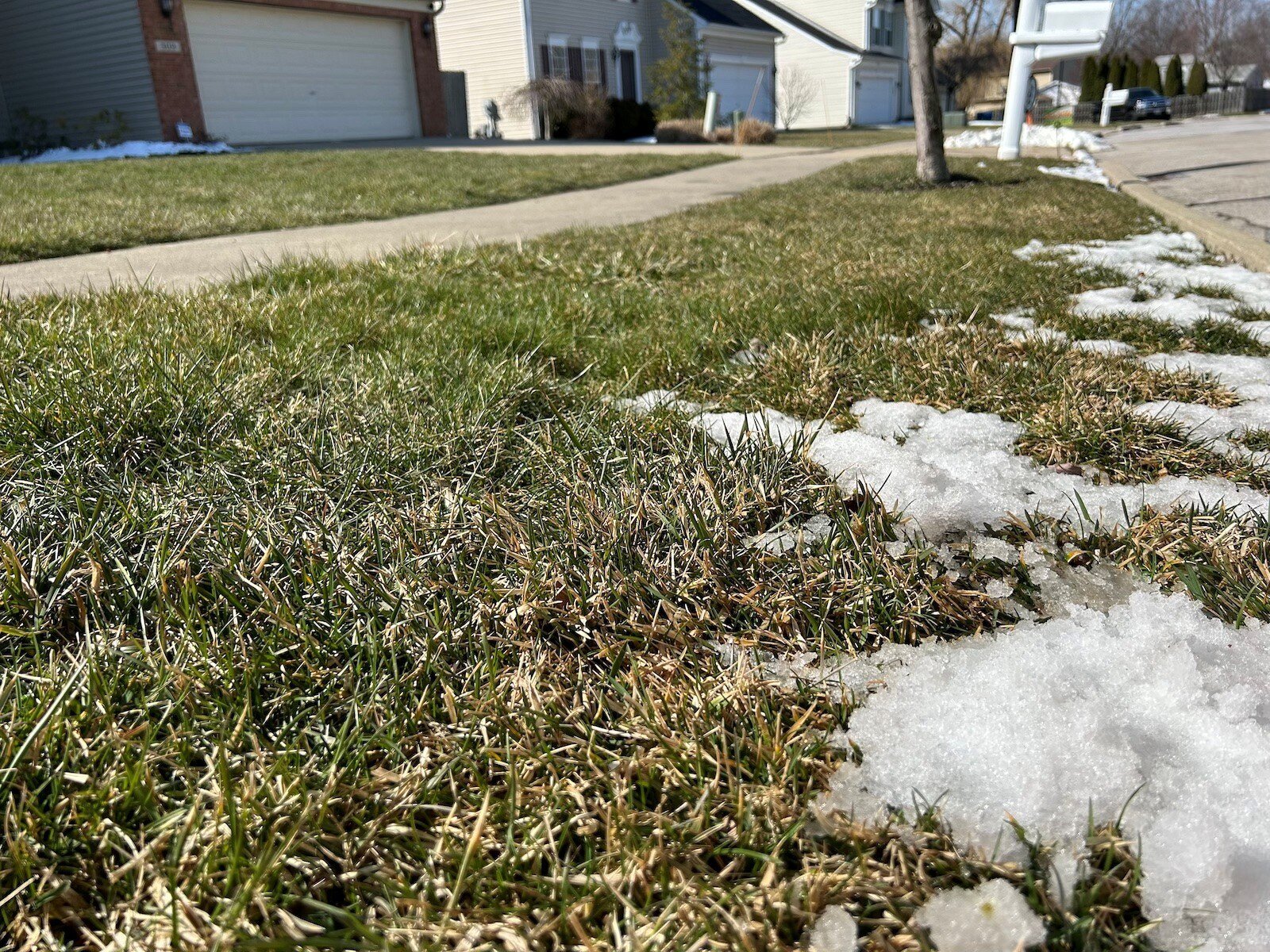
General Lawn Care Tips
If you properly take care of your lawn, you may not need to aerate and overseed as often. Keep these tips in mind to make sure your yard stays in tiptop shape for longer periods of time.
- Cutting grass too short stresses out your yard by taking off more of the grass blade than necessary. Consider mowing more often but cutting less of the grass blades off each time.
- Not watering enough can lead to drought stress and open up the door for weeds and diseases to take over.
- Watering too much or watering at night can lead to excessive moisture on the grass, creating optimal conditions for diseases to infiltrate.
- Nutrient deficiency means your grass doesn’t have the resources it needs to thrive. You can remedy this by adding in nutrients through fertilization.
FAQ About Aeration & Overseeding in Ohio
Should I do this every year?
If your yard is comprised of mostly tall fescue and Kentucky bluegrass and is generally lush and healthy, we recommend you aerate and overseed every other year, or even every three to four years once you’ve had the service performed.
For other customers who have lawns that are frequently cut too short or are constantly drying out, we recommend the service at least once every other year.
Can I skip aeration and just overseed?
It won’t harm your turf to only overseed without aerating, but by only overseeding, you’re not giving the grass seed the best chance to thrive. By aerating, you’re providing little pockets of protection for the seeds to be safe from elements and wildlife. It also makes it easier for the seeds to latch on to the soil.
What if my yard has limited access?
If your backyard has a narrow gate or entryway, our technicians can still perform the services. We will simply use a walk-behind aerator rather than a ride-on machine and then spread the seed by hand.
How long before I see results?
You can expect to see the full results of aeration and overseeding services the following April or May when lawns are coming out of dormancy and you’re cutting regularly.
Keep in mind that your results may vary based on the initial condition of your yard, the weather for the remainder of the season, and the steps you take following the service. If your lawn originally had a lot of bald or rocky spots, aeration and overseeding will improve the overall condition, but it’s not an instant one-step cure-all, and if the bare or rocky areas are greater than 5 feet in diameter, your lawn may require a full renovation program.
/front%20of%20home%20green%20lawn%20with%20large%20tree.jpg?width=1200&height=676&name=front%20of%20home%20green%20lawn%20with%20large%20tree.jpg)
Will overseeding fix a weed problem?
Absolutely. By consistently filling in bare spots with a seed mixture that’s best suited to the Northeast OH climate, you eliminate a lot of spaces where weeds would have infiltrated. The best way to control weeds is by having thick, healthy turf. The more grass you're putting in your yard, the fewer weeds you will have to deal with.
What if it rains, freezes, or birds eat my seed?
Because the seed is inputted directly into the ground as soon as the aerator creates the holes, this eliminates the risk of birds or other animals eating the seed, the seed being exposed to freezing temperatures, or rain washing away the seed.
Reach out to Turf Pride for Personalized Advice
If you are done staring at the bare or thin spots in your lawn, we can help. We pull from the experience of hundreds of customers served and dozens of years of experience to help you figure out what’s going wrong in your yard and how to fix it.
/Turf%20Pride%20team%20posing%20in%20front%20of%20truck.jpg?width=1200&height=676&name=Turf%20Pride%20team%20posing%20in%20front%20of%20truck.jpg)
If you are located in Mentor, Chardon, Beachwood, Willoughby, and nearby areas, reach out and request a free quote today.


